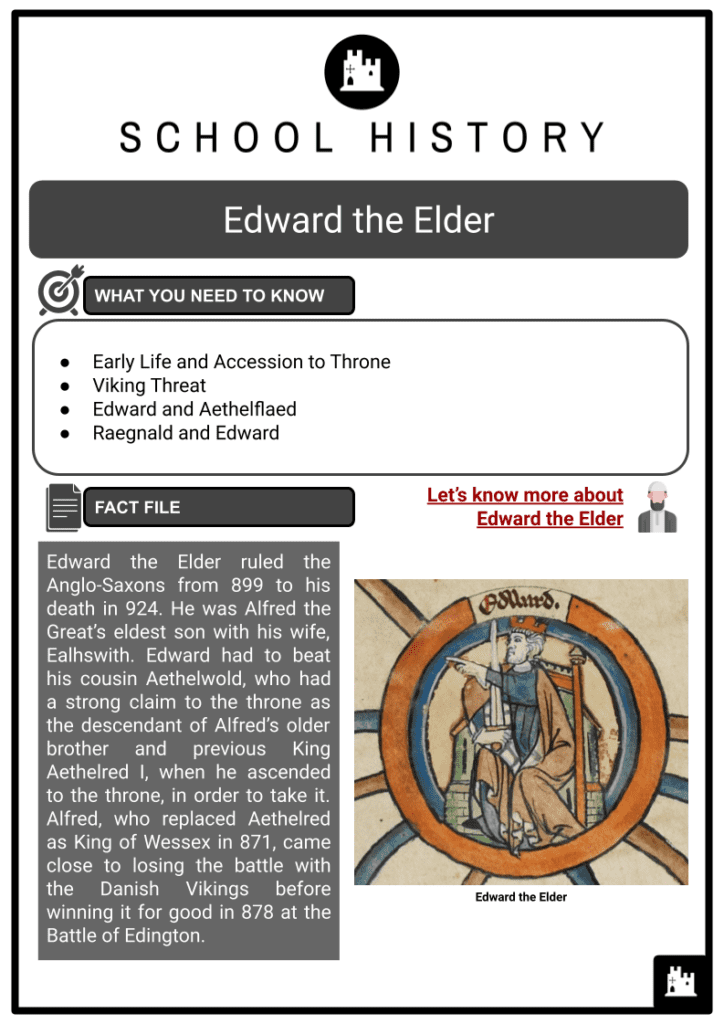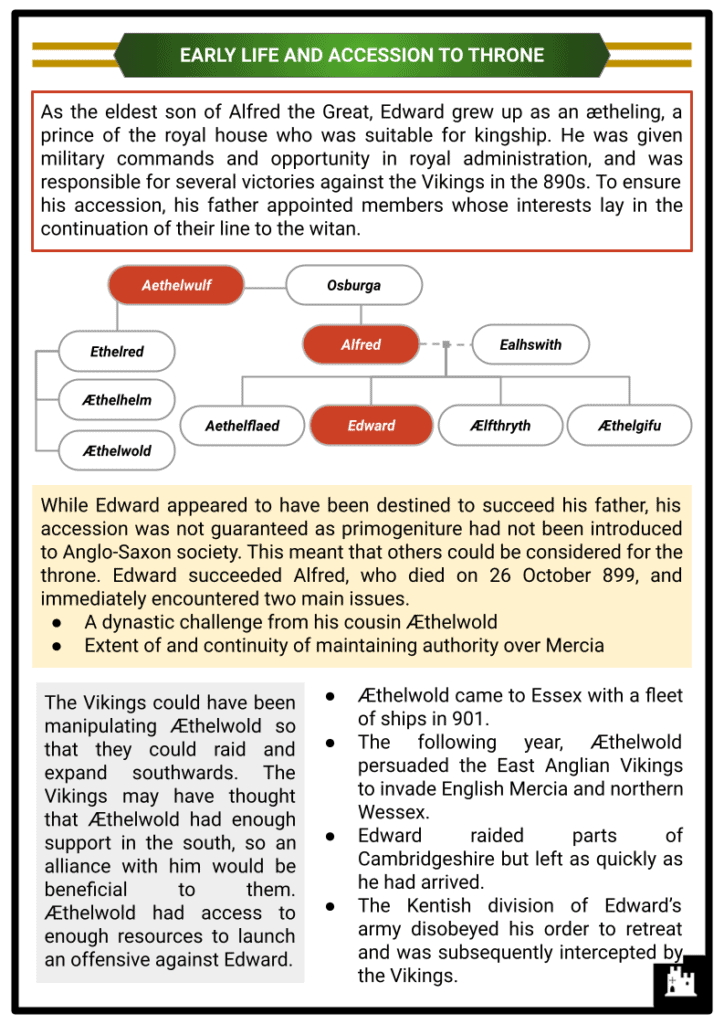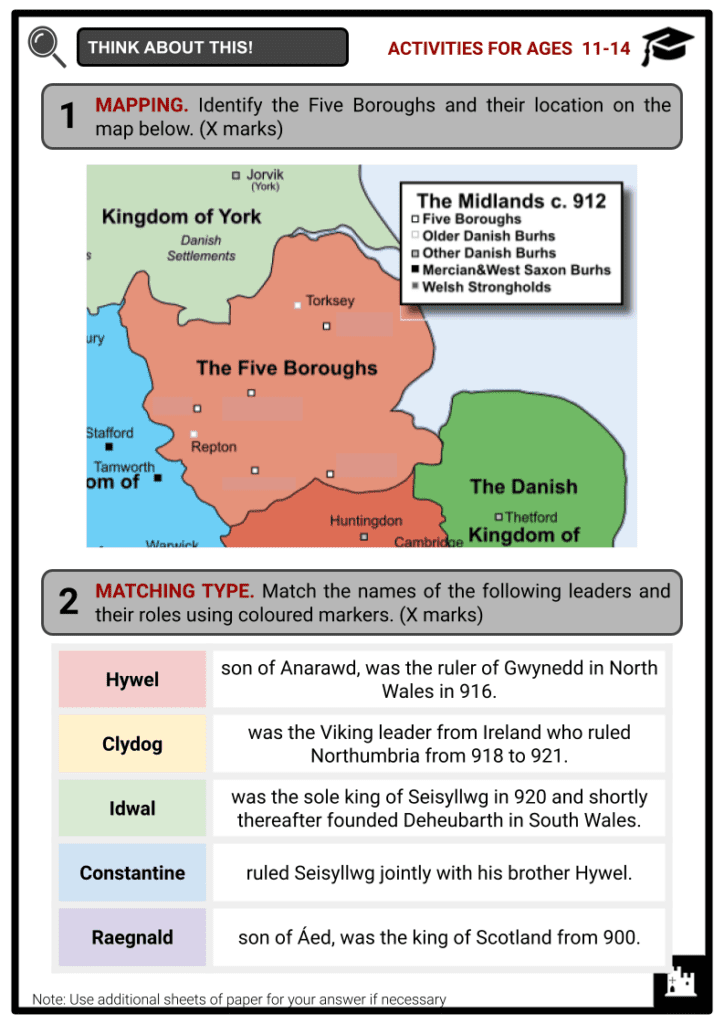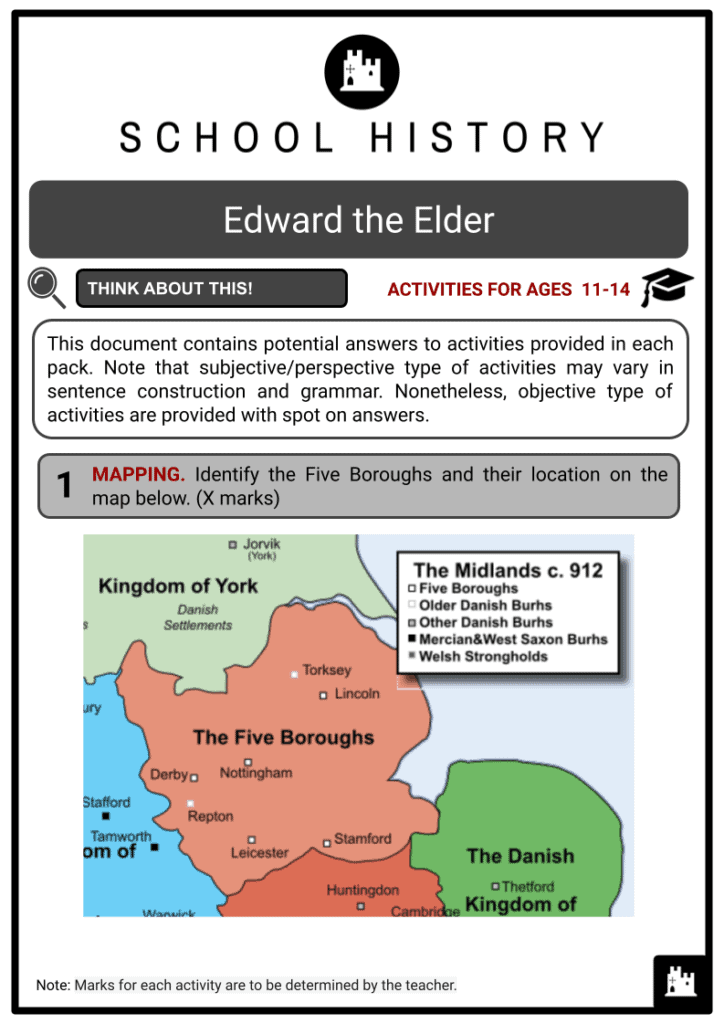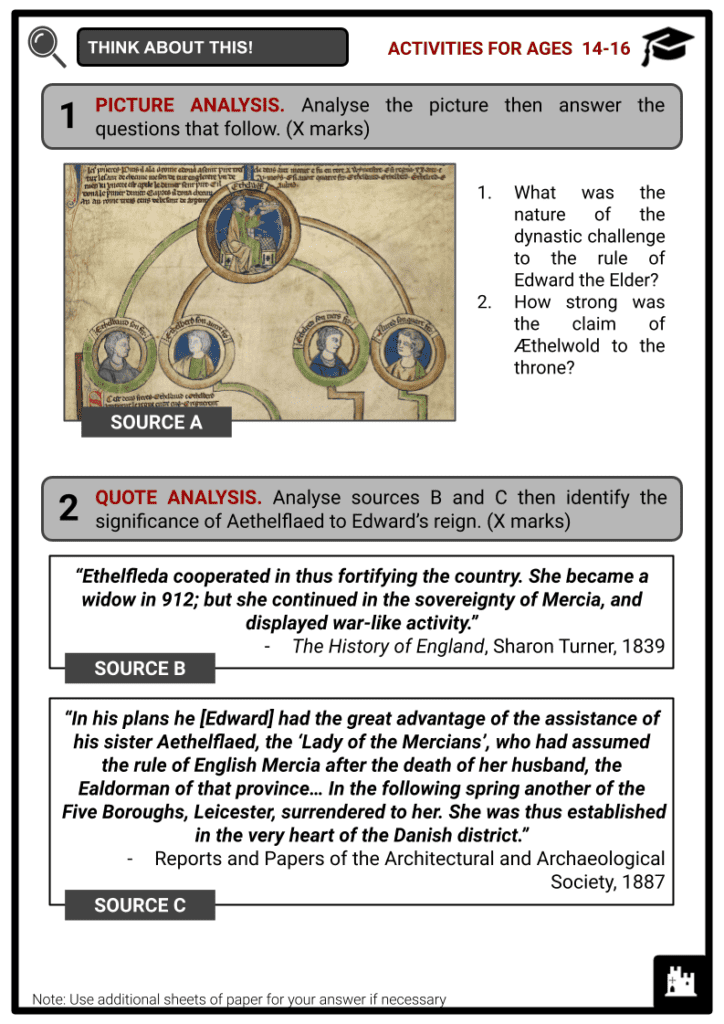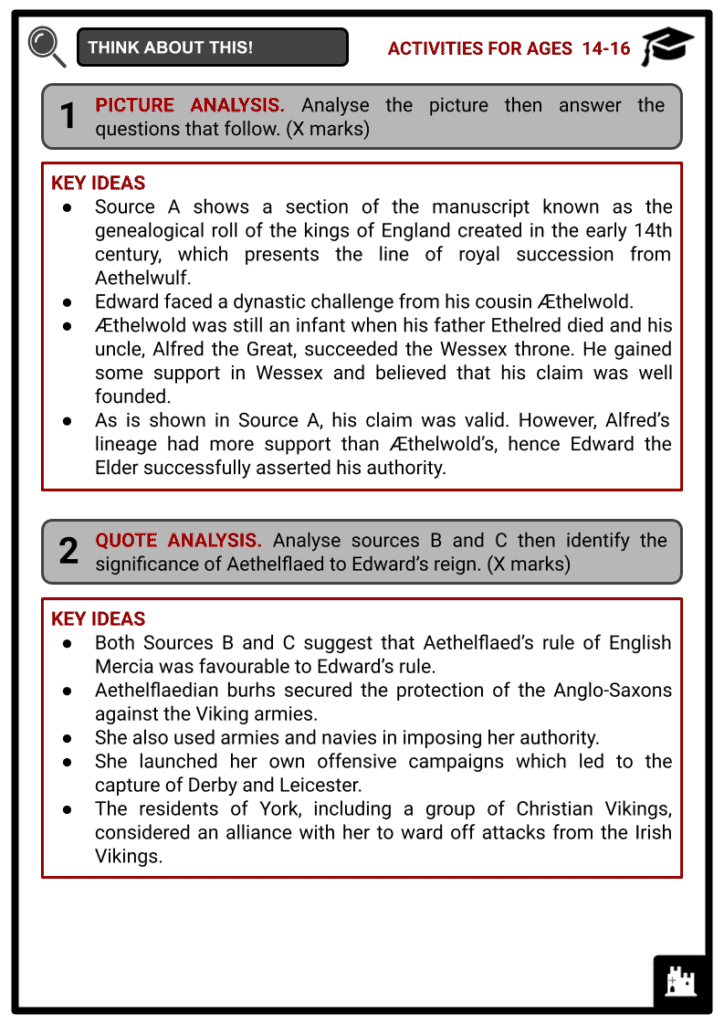Edward the Elder Worksheets
Do you want to save dozens of hours in time? Get your evenings and weekends back? Be able to teach about Edward the Elder to your students?
Our worksheet bundle includes a fact file and printable worksheets and student activities. Perfect for both the classroom and homeschooling!
Summary
- Early Life and Accession to Throne
- Viking Threat
- Edward and Aethelflaed
- Raegnald and Edward
Key Facts And Information
Let’s know more about Edward the Elder!
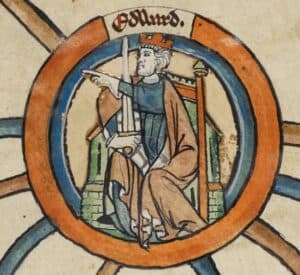
Edward the Elder ruled the Anglo-Saxons from 899 to his death in 924. He was Alfred the Great’s eldest son with his wife, Ealhswith. Edward had to beat his cousin Aethelwold, who had a strong claim to the throne as the descendant of Alfred’s older brother and previous King Aethelred I, when he ascended to the throne, in order to take it. Alfred, who replaced Aethelred as King of Wessex in 871, came close to losing the battle with the Danish Vikings before winning it for good in 878 at the Battle of Edington.
EARLY LIFE AND ACCESSION TO THRONE
- As the eldest son of Alfred the Great, Edward grew up as an ætheling, a prince of the royal house who was suitable for kingship. He was given military commands and opportunity in royal administration, and was responsible for several victories against the Vikings in the 890s. To ensure his accession, his father appointed members whose interests lay in the continuation of their line to the witan.
- While Edward appeared to have been destined to succeed his father, his accession was not guaranteed as primogeniture had not been introduced to Anglo-Saxon society. This meant that others could be considered for the throne. Edward succeeded Alfred, who died on 26 October 899, and immediately encountered two main issues.
- A dynastic challenge from his cousin Æthelwold
- Extent of and continuity of maintaining authority over Mercia
- The Vikings could have been manipulating Æthelwold so that they could raid and expand southwards. The Vikings may have thought that Æthelwold had enough support in the south, so an alliance with him would be beneficial to them. Æthelwold had access to enough resources to launch an offensive against Edward.
- Æthelwold came to Essex with a fleet of ships in 901.

- The following year, Æthelwold persuaded the East Anglian Vikings to invade English Mercia and northern Wessex.
- Edward raided parts of Cambridgeshire but left as quickly as he had arrived.
- The Kentish division of Edward’s army disobeyed his order to retreat and was subsequently intercepted by the Vikings.
- The two sides fought at the Battle of the Holme.
- The Vikings won but suffered heavy losses. The death of Æthelwold at the battle ended the dynastic challenge.
- Another issue faced by Edward was his limited control over the Mercian leaders. However, it is suggested that his overlordship was accepted by Aethelred and Aethelflaed, Lord and Lady of the Mercians, before 910. Whilst Aethelred and Aethelflaed exercised a considerable amount of autonomy, Edward had the ultimate authority over Mercia.
- Edward successfully used marriage to tackle dynastic issues. His three marriages were associated with the need to manage such challenges. His first marriage was arranged to provide him a male heir. His marriage to Aelfflaed, the niece of Æthelwold, was designed to strengthen his claim to the throne. Lastly, his marriage to Eadgifu, a daughter of a Kentish ealdorman, aimed to maintain his foothold in the south-east.
VIKING THREAT
- Alfred’s reign was plagued by Viking attacks which were considerably controlled by the peace agreements he arranged with the Vikings. Finally, the treaty around 886–890 between Alfred and Guthrum settled the jurisdiction of the Vikings in the Anglo-Saxon kingdoms. This is thought to mark the founding of Danelaw. Danelaw was the part of England in which the laws of the Vikings held sway and dominated those of the Anglo-Saxons.
- The peace agreements, however, did not ultimately terminate the Viking threat to the rulers after Alfred. In fact, early in Edward’s reign, the Vikings conniving with Æthelwold proved they continued to pose a challenge to the Anglo-Saxon rule. Following the death of Æthelwold, a level of peace was established from 903 to 910 by the selling of lands to the Vikings, who arrived in England in large numbers.
- In 909, Edward changed the strategy towards the Vikings by launching raids against the Northumbrians.
- This suggests that Edward used force to warn against further Viking attacks.
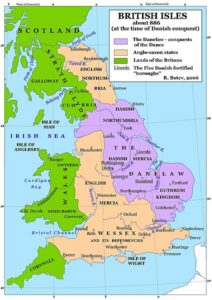
Danelaw (purple) - While Danelaw had been established in England, it was unclear what it constituted in a geographical, economic, social, cultural and political sense.
- By 903, the Scandinavian settlers were mainly a mixture of members of Viking armies and Danish migrants from Ireland, who consequently integrated with Anglo-Saxon society.
- The extent of settlement and integration varied in each area. The term Five Boroughs (Leicester, Lincoln, Nottingham, Stamford and Derby) indicates an element of collaboration between Scandinavian settlements.
EDWARD AND AETHELFLAED
- Edward and his sister Aethelflaed, Lady of the Mercians, strengthened the security of Wessex and Mercia against Viking attacks. They did this by continuing their father’s burghal system. Additionally, both used military force in establishing a ‘south-centred, Anglo-Saxon kingdom’. With the death of Aethelred in 911, Edward and Aethelflaed oversaw the construction of burhs in Mercia. A strategic pattern with respect to the subjugation of the Vikings can be distinguished from the burh construction.
- Aethelflaed’s programme of burh construction involved repairs and the addition of defences, mainly to secure protection against the Viking armies. To regain the territories believed to rightfully belong to the Anglo-Saxon people, Edward and Aethelflaed used their armies and navies in imposing their authority.
- Edward’s harrying of Northumbria in 909 prompted a Viking retaliation against Mercia the following year.
- This culminated in the Battle of Tettenhall in Staffordshire, in which the Vikings fought a combined Wessex and Mercian army.
- The Vikings were defeated: three prominent Viking kings, Halfdan, Eowils and Ivar, were killed at Tettenhall.
- The Vikings attacked Severn Valley in 914, but were forced to leave due to Edward’s forces in Hereford and Gloucester.
- In 917, Edward engaged with the Viking armies in Northampton, Huntingdon and other parts of East Anglia.
- He reinforced the defences of Towcester and Colchester, which effectively forced the Vikings to surrender. By 918, he became overlord of most of East Anglia.
- By 918, Edward’s position was significantly secured with his effective use of force and the construction of fortresses. Aethelflaed also played an essential role in the Anglo-Saxon success during 917–918. She launched her own offensive campaigns which led to the capture of Derby and Leicester. Consequently, the residents of York, including a group of Christian Vikings, considered an alliance with her to ward off attacks from the Irish Vikings. However, her death impeded this alliance. Edward assumed the title of King of Wessex and Mercia after the death of his sister.
RAEGNALD AND EDWARD
- As King of Wessex and Mercia, Edward received the submission of all the English Mercians previously under Aethelflaed. This supported the further consolidation of his authority over Mercia. What followed was the submission of the Welsh kings, the Scottish king and Raegnald to Edward’s rule according to the Anglo-Saxon Chronicle.
- Hywel, or Howell the Good, was the sole king of Seisyllwg in 920 and shortly thereafter founded Deheubarth in South Wales.
- Clydog ruled Seisyllwg jointly with his brother Hywel.
- Idwal, son of Anarawd, was the ruler of Gwynedd in North Wales in 916.
- Constantine, son of Áed, was the king of Scotland from 900.
- Raegnald was the Viking leader from Ireland who ruled Northumbria from 918 to 921.
- Whilst the Chronicle presented the events of the submission of these prominent rulers, the nature and extent of their submission were not clear. Furthermore, according to the Chronicle, Edward was sought and chosen to become the lord of the Welsh kings, Scottish king and Raegnald, which did not necessarily equate to submission. The use of the words ‘sought’ and ‘chose’ suggests that Edward’s authority was simply acknowledged by the rulers.
- Like England, Ireland had its share of Viking raids since 795 that continued for decades. The Vikings initially attacked the monasteries. Those who came from Norway were active along the southern and eastern coast of Ireland, and were later joined by others from Denmark in moving further inland to search for as much loot as they could find and to create encampments.
- The Irish resisted these attacks, but within a fairly short space of time the Viking settlements on the island allowed the emergence of the Hiberno-Norse culture. Dublin (Dubh-linn) was the most important centre of this hybrid culture. From 841, it developed as a relatively small but powerful kingdom. The Dublin Vikings lived there for over 50 years until they were forced to flee to the north-west region of England after suffering defeat to a combined force of Irish chieftains.
- Raegnald was the grandson of Ivar the Boneless and was probably among the Dublin Vikings who fled to England in 902. He was in Northumbria some time between 913 and 915. In 918, he fought the Scottish King Constantine and Ealdorman Ealdred of Bernicia at the Battle of Corbridge. This led to his proclamation as King of York and assertion of his authority over the Vikings in the region.
- This event amplified Edward’s fears of conflict that could arise from a growing Viking presence in the north. Edward’s programme of building fortifications was tested by Raegnald’s cousin Sihtric, who attacked north-west Mercia and ravaged Davenport in Cheshire. The heightened attacks led to a meeting in 920, in which Raegnald, alongside the Scottish king, chose Edward as father and lord. Whilst this meeting could have been significant with respect to Anglo-Saxon rule in the region, the deaths of Raegnald the following year and of Edward four years later left the decision of who was to maintain jurisdiction in northern Danelaw to their successors.

